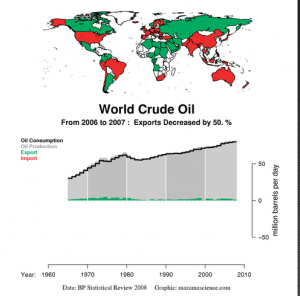According to Saul's calculations, in order to reach a goal of 450 ppm of atmospheric carbon dioxide in time to limit a global rise in temperature to 2 degrees C., we'll have to reduce the amount of burned fossil fuels to 3 terawatts (of power). That means we'll need to replace 11.5 terawatts with new clean sources.
From Stewart Brand's Long Now Blog:
That would mean the following. (Here I'm drawing on notes and extrapolations I've written up previously from discussion with Griffith):
"Two terawatts of photovoltaic would require installing 100 square meters of 15-percent-efficient solar cells every second, second after second, for the next 25 years. (That's about 1,200 square miles of solar cells a year, times 25 equals 30,000 square miles of photovoltaic cells.) Two terawatts of solar thermal? If it's 30 percent efficient all told, we'll need 50 square meters of highly reflective mirrors every second. (Some 600 square miles a year, times 25.) Half a terawatt of biofuels? Something like one Olympic swimming pools of genetically engineered algae, installed every second. (About 15,250 square miles a year, times 25.) Two terawatts of wind? That's a 300-foot-diameter wind turbine every 5 minutes. (Install 105,000 turbines a year in good wind locations, times 25.) Two terawatts of geothermal? Build 3 100-megawatt steam turbines every day-1,095 a year, times 25. Three terawatts of new nuclear? That's a 3-reactor, 3-gigawatt plant every week-52 a year, times 25."
All of it! Please listen to Saul's Long Now Lecture to hear how, despite the odds, he remains an optimist.
Calculate and compare your own power consumption at WattzOn.com.
Check out the very cool 100 mpg, charge-overnight-from-a-wall-socket, ready-for-the-carpool-lane, 3-wheeled (California only) Aptera.
(As mentioned in Saul's talk.)
See also: Google PowerMeter is currently being tested by employees and is not yet available to the public.
.








